Estimation and Prediction of Vertical Deformations of Random Surfaces, Applying the Total Least Squares Collocation Method
Abstract
:1. Introduction
2. Basic Assumptions and Models
2.1. Surface Fluctuation
2.2. Heights and Displacements Models
3. Optimisation Problem and Its Solution
4. Numerical Tests
4.1. Simulated Levelling Network
- Generation of mutually independent elements of vectors, , using generator .
- Creation of a covariance matrix of signals vector for the adopted covariance function , .
- Calculation of signals vectors , , based on the R matrix of , distribution and simulated vectors .
- Calculation of simulated random displacements vector of .
4.2. Real Free Control Network
5. Conclusions
Author Contributions
Funding
Conflicts of Interest
References
- Meo, M.; Zumpano, G. On the optimal sensor placement techniques for a bridge structure. Eng. Struct. 2005, 27, 1488–1497. [Google Scholar] [CrossRef]
- Glišić, B.; Inaudi, D. Fibre Optic Methods for Structural Health Monitoring; John Wiley & Sons: Chichester, UK, 2007; p. 276. [Google Scholar]
- Cai, J.; Wang, J.; Wu, J.; Hu, C.; Grafarend, E.; Chen, J. Horizontal deformation rate analysis based on multiepoch GPS measurements in Shanghai. J. Surv. Eng. 2008, 134, 132–137. [Google Scholar] [CrossRef]
- Li, L.; Kuhlmann, H. Deformation detection in the GPS real–time series by the multiple Kalman filters model. J. Surv. Eng. 2010, 136, 157–164. [Google Scholar] [CrossRef]
- Yi, T.H.; Li, H.N.; Gu, M. Experimental assessment of high–rate GPS receivers for deformation monitoring of bridge. Measurement 2013, 46, 420–432. [Google Scholar] [CrossRef]
- Xiao, Z.; Liang, J.; Yu, D.; Asundi, A. Large field–of–view deformation measurement for transmission tower based on close–range photogrammetry. Measurement 2011, 44, 1705–1712. [Google Scholar] [CrossRef]
- Lindenbergh, R.; Pietrzyk, P. Change detection and deformation analysis using static and mobile laser scanning. Appl. Geomat. 2015, 7, 65–74. [Google Scholar] [CrossRef]
- Pingue, F.; Petrazzuoli, S.M.; Obrizzo, F.; Tammaro, U.; De Martino, P.; Zuccaro, G. Monitoring system of buildings with high vulnerability in presence of slow ground deformations (The Campi Flegrei, Italy, case). Measurement 2011, 44, 1628–1644. [Google Scholar] [CrossRef]
- Baselga, S.; García–Asenjo, L.; Garrigues, P. Deformation monitoring and the maximum number of stable points method. Measurement 2015, 70, 27–35. [Google Scholar] [CrossRef]
- Chen, Y.Q.; Chrzanowski, A.; Secord, J.M. A strategy for the analysis of the stability of reference points in deformation surveys. CISM JACSGG 1990, 44, 141–149. [Google Scholar] [CrossRef]
- Amiri–Simkooei, A.R.; Alaei–Tabatabaei, S.M.; Zangeneh–Nejad, F.; Voosoghi, B. Stability Analysis of Deformation–Monitoring Network Points Using Simultaneous Observation Adjustment of Two Epochs. J. Surv. Eng. 2017, 143, 1–12. [Google Scholar] [CrossRef] [Green Version]
- Koch, K.R. Parameter Estimation and Hypothesis Testing in Linear Models, 2nd ed.; Springer: Berlin/Heidelberg, Germany, 1999; p. 334. [Google Scholar] [CrossRef]
- Durdag, U.M.; Hekimoglu, S.; Erdogan, B. Reliability of Models in Kinematic Deformation Analysis. J. Surv. Eng. 2018, 144, 1–15. [Google Scholar] [CrossRef]
- Duchnowski, R.; Wiśniewski, Z. Estimation of the shift between parameters of functional models of geodetic observations by applying Msplit estimation. J. Surv. Eng. 2012, 138, 1–8. [Google Scholar] [CrossRef]
- Wiśniewski, Z.; Zienkiewicz, M.H. Shift–M*split estimation in deformation analyses. J. Surv. Eng. 2016, 142, 1–13. [Google Scholar] [CrossRef]
- Chen, Y.Q. Analysis of Deformation Surveys—A Generalized Method; Technical Report No. 94; University of New Brunswick: Fredericton, NB, USA, 1983; pp. 54–72. [Google Scholar]
- Caspary, W.F. Concepts of Network and Deformation Analysis; The University of New South Wales: Utrecht, The Netherlands, 2000; p. 183. Available online: https://trove.nla.gov.au/version/39909771 (accessed on 27 February 2020).
- Even-Tzur, G. Deformation analysis by means of extended free network adjustment constraints. J. Surv. Eng. 2011, 137, 47–52. [Google Scholar] [CrossRef]
- Nowel, K.; Kamiński, W. Robust estimation from observation differences for free control networks. J. Geod. 2014, 88, 749–764. [Google Scholar] [CrossRef] [Green Version]
- Denli, H.H. Stable point research on deformation networks. Surv. Rev. 2008, 40, 74–82. [Google Scholar] [CrossRef]
- Mittermayer, E. Zur Ausgleichung freier Netze. Zeitschrift für Vermessungswesen (ZFV) 1972, 11, 481–489. [Google Scholar]
- Mittermayer, E. A generalization of the least–squares method for the adjustment of free networks. Bull. Géodésique 1972, 104, 139–157. [Google Scholar] [CrossRef]
- Wolf, H. Helmers Lösung zum Problem der freien Netze mit singulärer Normal–gleichungsmatrix. Zeitschrift für Vermessungswesen (ZFV) 1972, 5, 189–192. [Google Scholar]
- Perelmuter, A. Adjustment of free networks. Bull. Géodésique 1979, 53, 291–296. [Google Scholar] [CrossRef]
- Papo, H.B.; Perelmuter, A. Datum definition by free net adjustment. Bull. Géodésique 1981, 55, 218–226. [Google Scholar] [CrossRef]
- Caetano, E.; Silva, S.; Bateira, J. A vision system for vibration monitoring of civil engineering structures. Exp. Tech. 2011, 35, 74–82. [Google Scholar] [CrossRef]
- Flesch, R.; Kahmen, H. Building structures as kinematic systems—Dynamic monitoring and system analysis. Int. Assoc. Geod. Symp. 1999, 121, 313–318. [Google Scholar] [CrossRef]
- Reynolds, P. Dynamic testing and monitoring of civil engineering structures. Exp. Tech. 2008, 32. [Google Scholar] [CrossRef]
- Rogozhin, E.A.; Kapustian, N.K.; Antonovskaya, G.N. A New System for Monitoring Hydraulic Engineering Structures. Seism. Instrum. 2018, 54, 531–535. [Google Scholar] [CrossRef]
- Amezquita–Sanchez, J.P.; Adeli, H. Signal Processing Techniques for Vibration–Based Health Monitoring of Smart Structures. Arch. Comput. Methods Eng. 2016, 23, 1–15. [Google Scholar] [CrossRef]
- Krarup, T. A Contribution to the Mathematical Foundation of Physical Geodesy; Publish no. 44; Danish Geodetic Institute: Copenhagen, Denmark, 1969; p. 80. [Google Scholar]
- Moritz, H. A generalized least–squares model. Studia Geophysica Geodaetica 1970, 14, 353–362. [Google Scholar] [CrossRef]
- Moritz, H. Advanced least–squares methods. Department of Geodetic Science, Report; No. 175; Ohio State University: Columbus, OH, USA, 1972. [Google Scholar]
- Moritz, H. Least–Squares Collocation; Deutsche Geodatische Kommission Reihe a Heft: München, Germany, 1973; p. 75. [Google Scholar]
- Koch, K.R. Least squares adjustment and collocation. Bull. Géodésique 1977, 51, 127–135. [Google Scholar] [CrossRef]
- Tscherning, C.C. Collocation and least squares methods as a tool for handling gravity field dependent data obtained through space research techniques. Bull. Géodésique 1978, 52, 199–212. [Google Scholar] [CrossRef]
- Kotsakis, C. The multiresolution character of collocation. J. Geod. 2000, 74, 275–290. [Google Scholar] [CrossRef]
- Kotsakis, C. Least–squares collocation with covariance–matching constraints. J. Geod. 2007, 81, 661–677. [Google Scholar] [CrossRef]
- Deakin, R.E.; Collier, P.A.; Leahy, F.J. Transformation of coordinates using least squares collocation. Aust. Surv. 1994, 396–418. [Google Scholar] [CrossRef]
- Kutoglu, H.; Ayan, T.; Mekik, C. Integrating GPS with national networks by collocation method. Appl. Math. Comput. 2006, 177, 508–514. [Google Scholar] [CrossRef]
- You, R.J.; Hwang, H.W. Coordinate transformation between two geodetic datums of Taiwan by least–squares collocation. J. Surv. Eng. 2006, 132, 64–70. [Google Scholar] [CrossRef]
- Yang, Y.; Zeng, A.; Zhang, J. Adaptive collocation with application in height system transformation. J. Geod. 2009, 83, 403–410. [Google Scholar] [CrossRef]
- Mao, O.; Zhang, L.; Hu, Q.; Yu, J.; Feng, S.; Washington, O.; Gong, H. A least squares collocation method for accuracy improvement of mobile LiDAR systems. Remote Sens. 2015, 7, 7402–7424. [Google Scholar] [CrossRef] [Green Version]
- Tscherning, C.C. Testing frame transformation, gridding and filtering of GOCE gradiometer data by least–squares collocation using simulated data. IAG Proc. 2004, 128, 277–282. [Google Scholar] [CrossRef]
- Tscherning, C.C. The use of least–squares collocation for the processing of GOCE data. Oesterreichische Z. Fuer Vermess. Geoinf. (Austrian Mag. Surv. Geoinf.) 2010, 98, 21–26. [Google Scholar]
- Gómez, D.; Piñón, D.; Smalley, R.; Bevis, M.; Cimbaro, S.; Lenzano, L.; Barón, J. Reference frame access under the effects of great earthquakes: A least squares collocation approach for non–secular post–seismic evolution. J. Geod. 2016, 90, 263–273. [Google Scholar] [CrossRef]
- Yang, Y. Robustifying collocation. Manuscr. Geod. 1992, 17, 21–28. [Google Scholar]
- Schaffrin, B.; Wieser, A. On weighted total least–squares adjustment for linear regression. J. Geod. 2008, 82, 415–421. [Google Scholar] [CrossRef]
- Shen, Y.; Li, B.; Chen, Y. An iterative solution of weighted total least–squares adjustment. J. Geod. 2011, 85, 229–238. [Google Scholar] [CrossRef]
- Mahboub, V. On weighted total least–squares for geodetic transformations. J. Geod. 2012, 86, 359–367. [Google Scholar] [CrossRef]
- Ditlevsen, O. Traffic loads on large bridges modeled as white–noise fields. ASCE J. Eng. Mech. 1994, 120, 681–694. [Google Scholar] [CrossRef]
- Lifshits, M.A. Gaussian Random Functions; Spinger Science+Business Media: Dordrecht, The Netherlands, 1995; p. 337. [Google Scholar] [CrossRef]
- Koch, K.R. Bayesian Inference with Geodetic Applications; Springer: Berlin/Heidelberg, Germany, 1990; p. 199. [Google Scholar] [CrossRef]
- Osborne, M. Bayesian Gaussian Processes for Sequential Prediction, Optimization and Quadrature; New College, University of Oxford: London, UK, 2010. [Google Scholar]
- Magnus, J.R. Linear Structures; Charles Griffin and Company Ltd.: London, UK; Oxford University Press: London, UK, 1988. [Google Scholar]
- Bock, Y. Estimating crustal deformations from a combination of baseline measurements and geophysical models. J. Geod. 1983, 57, 294–311. [Google Scholar] [CrossRef]
- Rao, C.R. Linear Statistical Inference and Its Applications; John Wiley & Sons Inc.: New York, NY, USA, 1973. [Google Scholar] [CrossRef]
- Moritz, H. Statistical foundations of collocation. Boll. Geod. Sci. Affini 1980, 2, 131–150. [Google Scholar]
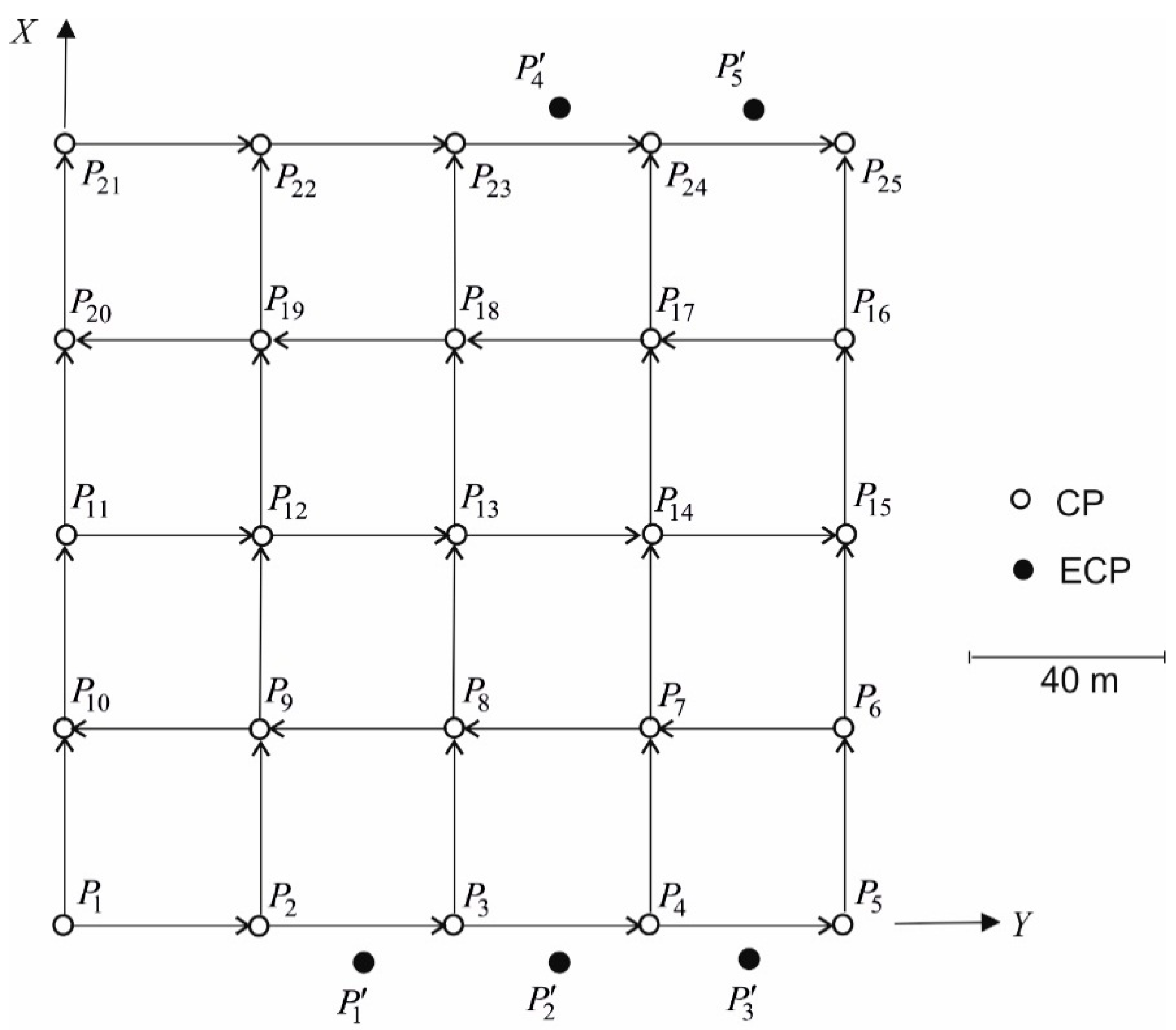

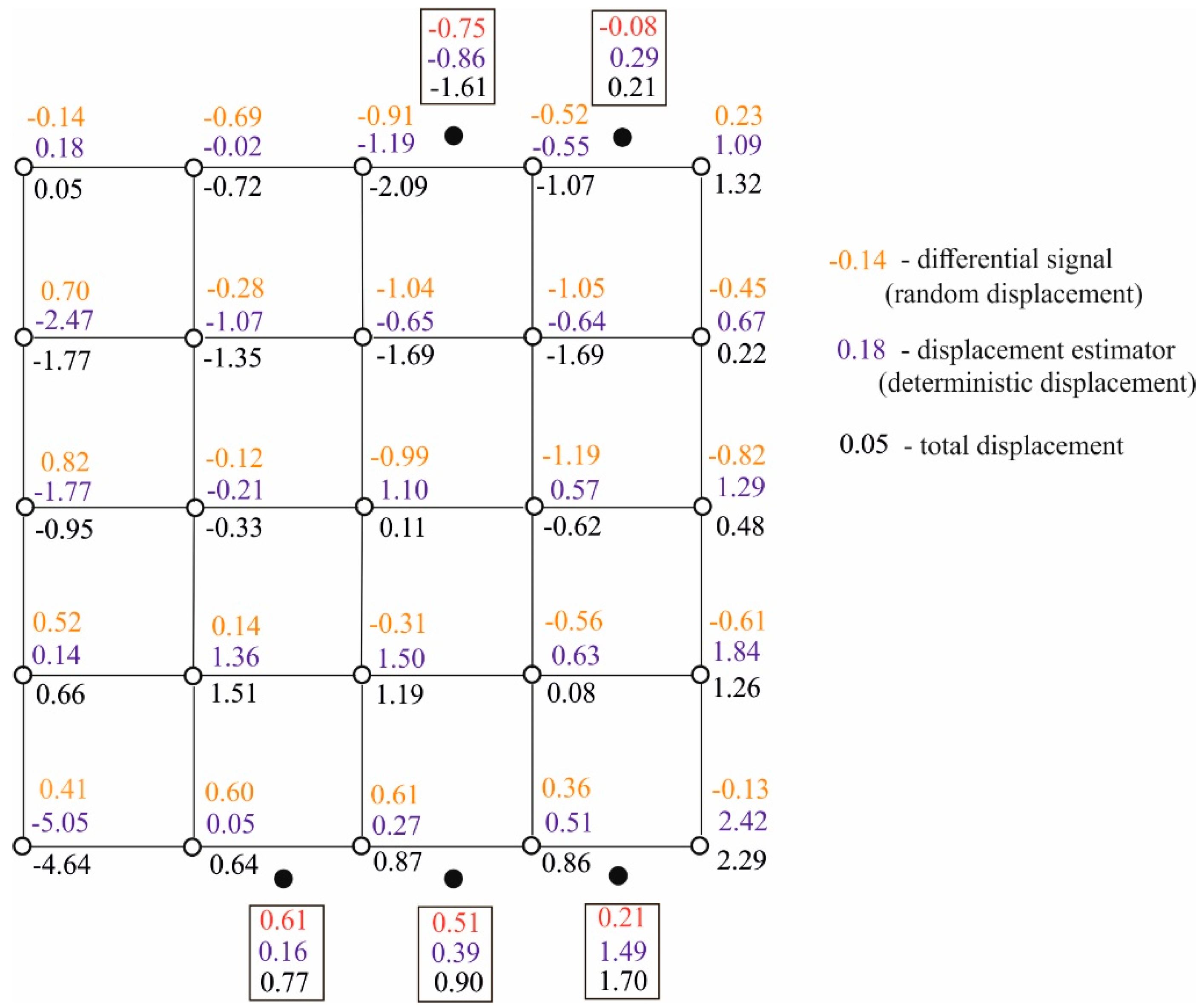


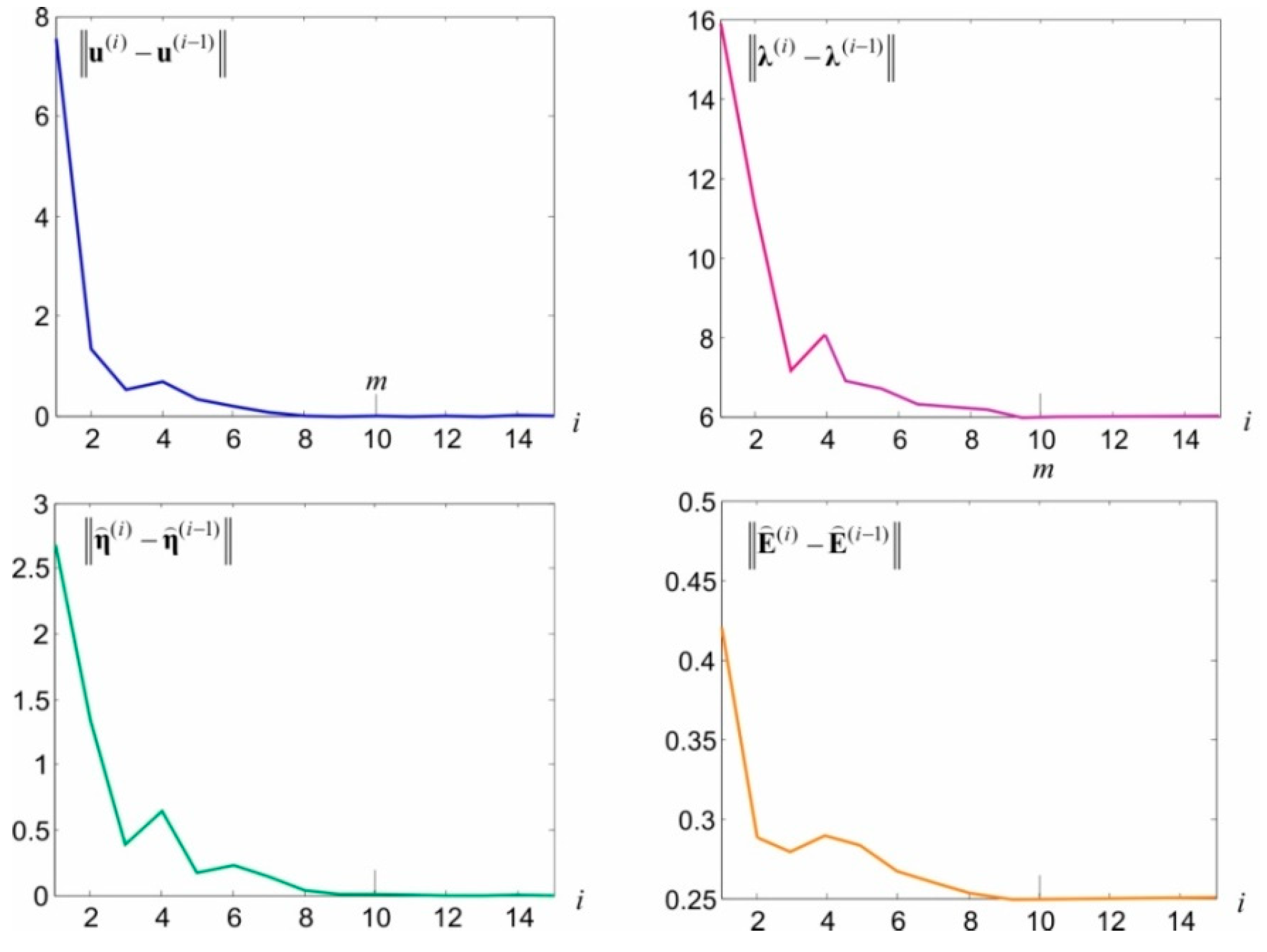

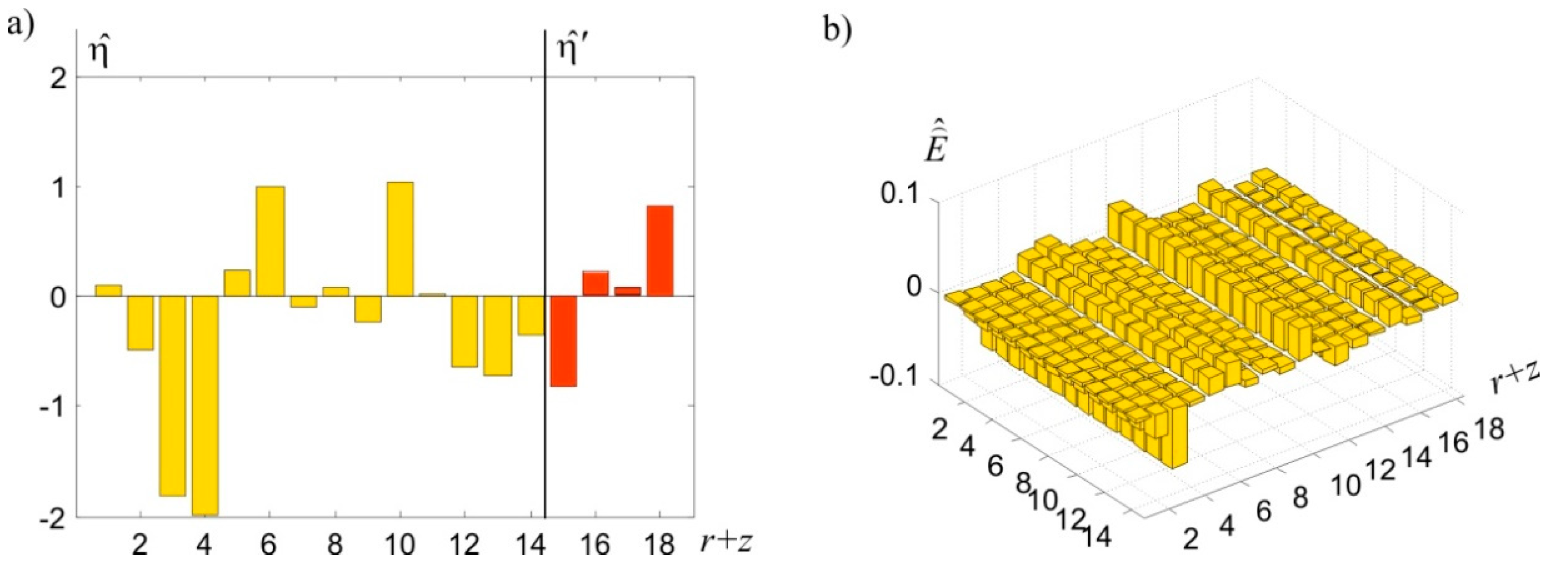
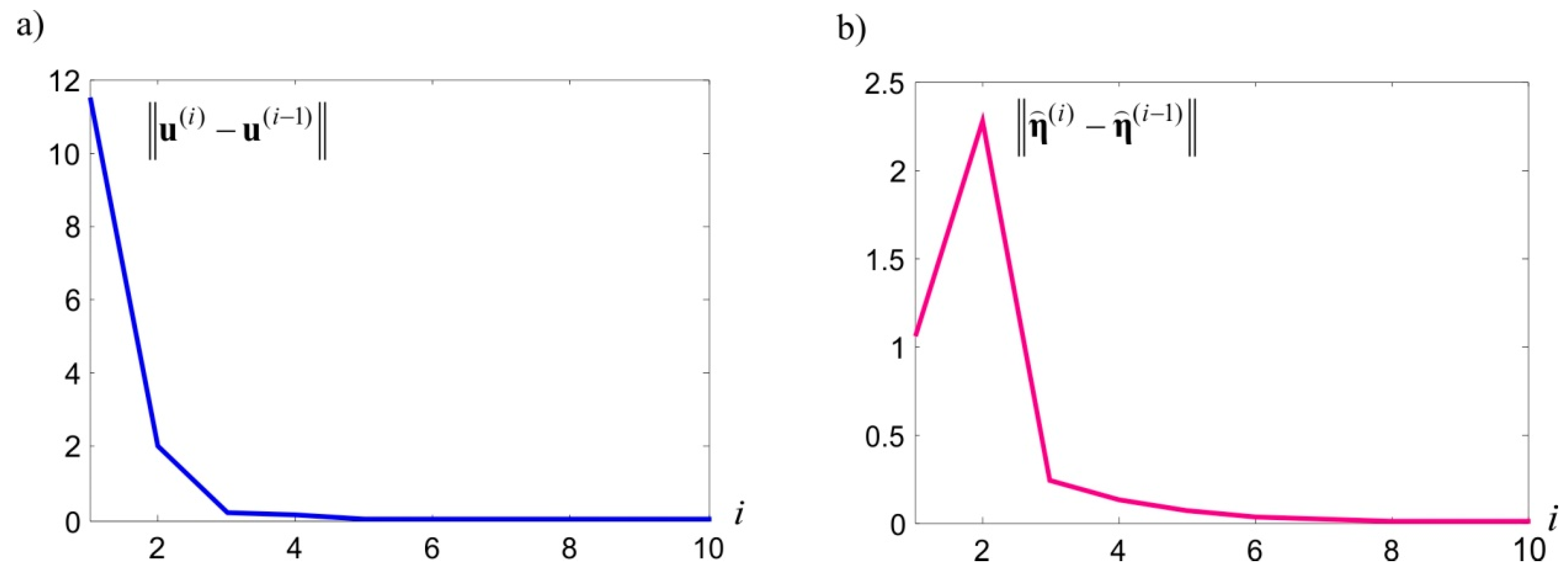
| 0.0 | 0.1 | 0.2 | 0.3 | 0.0 | 0.1 | 0.2 | 0.3 | 0.0 | 0.1 | 0.2 | 0.3 | |
| 0.24 | 0.24 | 0.24 | 0.24 | 0.29 | 0.29 | 0.29 | 0.29 | 0.40 | 0.40 | 0.40 | 0.40 | |
| 0.24 | 0.24 | 0.24 | 0.24 | 0.29 | 0.29 | 0.29 | 0.29 | 0.40 | 0.40 | 0.40 | 0.40 | |
| 0.0 | 0.1 | 0.2 | 0.3 | 0.0 | 0.1 | 0.2 | 0.3 | 0.0 | 0.1 | 0.2 | 0.3 | |
| 0.46 | 0.63 | 0.99 | 1.41 | 0.49 | 0.66 | 1.00 | 1.40 | 0.57 | 0.71 | 1.03 | 1.44 | |
| 0.24 | 0.24 | 0.24 | 0.24 | 0.29 | 0.29 | 0.29 | 0.29 | 0.40 | 0.40 | 0.40 | 0.40 | |
| 0.0 | 0.1 | 0.2 | 0.3 | 0.0 | 0.1 | 0.2 | 0.3 | 0.0 | 0.1 | 0.2 | 0.3 | |
| 0.81 | 0.93 | 1.21 | 1.55 | 0.84 | 0.94 | 1.20 | 1.56 | 0.89 | 1.00 | 1.24 | 1.58 | |
| 0.24 | 0.24 | 0.24 | 0.24 | 0.29 | 0.29 | 0.29 | 0.29 | 0.40 | 0.40 | 0.40 | 0.40 | |
| CP | |||||||
|---|---|---|---|---|---|---|---|
| −5 | −4.43 | −5.05 | 0.87 | 0.41 | −4.13 | −4.64 | |
| 0 | 0.86 | 0.05 | 0.57 | 0.60 | 0.57 | 0.64 | |
| 0 | 1.09 | 0.27 | 0.09 | 0.61 | 0.09 | 0.87 | |
| 0 | 1.08 | 0.51 | 0.11 | 0.36 | 0.11 | 0.86 | |
| 0 | 2.50 | 2.42 | 0.78 | −0.13 | 0.78 | 2.29 | |
| 0 | 1.44 | 1.84 | 0.45 | −0.61 | 0.45 | 1.23 | |
| 0 | 0.29 | 0.63 | −0.07 | −0.56 | −0.07 | 0.08 | |
| 0 | 1.40 | 1.50 | 0.11 | −0.31 | 0.11 | 1.19 | |
| 0 | 1.72 | 1.36 | 0.71 | 0.14 | 0.71 | 1.51 | |
| 0 | 0.88 | 0.14 | 0.81 | 0.52 | 0.81 | 0.66 | |
| 0 | −0.73 | −1.77 | −0.05 | 0.82 | −0.05 | −0.95 | |
| 0 | −0.11 | −0.21 | −0.26 | −0.12 | −0.26 | −0.33 | |
| 0 | 0.33 | 1.10 | −0.78 | −0.99 | −0.78 | 0.11 | |
| 0 | −0.40 | 0.57 | −0.61 | −1.19 | −0.61 | −0.62 | |
| 0 | 0.69 | 1.29 | 0.14 | −0.82 | 0.14 | 0.48 | |
| 0 | 0.44 | 0.67 | −0.11 | −0.45 | −0.11 | 0.22 | |
| 0 | −1.48 | −0.64 | −1.15 | −1.05 | −1.15 | −1.69 | |
| 0 | −1.47 | −0.65 | −1.58 | −1.04 | −1.58 | −1.69 | |
| 0 | −1.13 | −1.07 | −1.04 | −0.28 | −1.04 | −1.35 | |
| 0 | −1.55 | −0.47 | −0.73 | 0.70 | −0.73 | −1.77 | |
| 0 | 0.27 | 0.18 | −0.86 | −0.14 | −0.86 | 0.05 | |
| 0 | −0.50 | −0.02 | −0.98 | −0.69 | −0.98 | −0.72 | |
| 0 | −1.88 | –1.19 | –1.38 | –0.91 | –1.38 | –2.09 | |
| 0 | –0.85 | – 0.55 | –0.87 | –0.52 | –0.87 | –1.07 | |
| 0 | 1.53 | 1.09 | 0.22 | 0.23 | 0.22 | 1.32 | |
| ECP | |||||||
| – | – | 0.16 | 0.19 | 0.61 | – | 0.77 | |
| – | – | 0.39 | 0.10 | 0.51 | – | 0.90 | |
| – | – | 1.49 | 0.41 | 0.21 | − | 1.70 | |
| − | − | −0.86 | −1.16 | −0.75 | − | −1.61 | |
| − | − | 0.29 | −0.19 | −0.08 | − | 0.21 | |
| −6.9 | 11.6 | −13.2 | −25.3 | −3.6 | −14.9 | 20.6 | −3.4 | 8.5 | −15.7 | 8.2 | 0.1 | 12.1 | −29.7 | |
| −3.5 | 8.9 | −6.6 | 23.4 | −1.2 | −13.9 | 23.2 | −2.7 | 10.8 | −17.5 | 7.9 | −0.4 | 14.8 | −38.2 | |
| 3.4 | −2.7 | 6.6 | −1.9 | 2.4 | 1.0 | 2.6 | 0.7 | 2.3 | −1.8 | −0.3 | −0.5 | 2.7 | −8.5 |
| CP | |||||||
| −5.97 | −6.10 | −6.35 | 0.03 | 0.10 | −6.07 | −6.24 | |
| −2.98 | −2.91 | −2.76 | −0.16 | −0.49 | −3.07 | −3.25 | |
| −6.12 | −5.60 | −4.58 | −0.61 | −1.82 | −6.21 | −6.39 | |
| 0.05 | 0.62 | 1.76 | −0.66 | −1.99 | −0.04 | −0.23 | |
| −2.27 | −2.44 | −2.78 | 0.08 | 0.24 | −2.36 | −2.54 | |
| −0.29 | −0.72 | −1.57 | 0.33 | 1.00 | −0.39 | −0.57 | |
| 0.27 | 0.21 | 0.09 | −0.03 | −0.09 | 0.18 | −0.00 | |
| 2.45 | 2.33 | 2.09 | 0.03 | 0.08 | 2.36 | 2.17 | |
| 2.72 | 2.70 | 2.67 | −0.08 | −0.23 | 2.62 | 2.44 | |
| 4.60 | 4.16 | 3.30 | 0.34 | 1.03 | 4.50 | 4.32 | |
| 2.35 | 2.25 | 2.06 | 0.01 | 0.02 | 2.26 | 2.07 | |
| 1.59 | 1.72 | 1.96 | −0.21 | −0.64 | 1.51 | 1.32 | |
| 0.66 | 0.80 | 1.09 | −0.24 | −0.71 | 0.56 | 0.38 | |
| 2.95 | 2.97 | 3.02 | −0.12 | −0.35 | 2.85 | 2.67 | |
| ECP | |||||||
| −0.81 | −0.37 | −0.28 | −0.83 | −1.09 | −1.20 | ||
| −0.13 | −0.51 | 0.07 | 0.21 | −0.06 | −0.30 | ||
| 2.48 | 2.32 | 0.01 | 0.04 | 2.49 | 2.36 | ||
| 3.52 | 2.87 | 0.27 | 0.81 | 3.79 | 3.68 | ||
© 2020 by the authors. Licensee MDPI, Basel, Switzerland. This article is an open access article distributed under the terms and conditions of the Creative Commons Attribution (CC BY) license (http://creativecommons.org/licenses/by/4.0/).
Share and Cite
Wiśniewski, Z.; Kamiński, W. Estimation and Prediction of Vertical Deformations of Random Surfaces, Applying the Total Least Squares Collocation Method. Sensors 2020, 20, 3913. https://doi.org/10.3390/s20143913
Wiśniewski Z, Kamiński W. Estimation and Prediction of Vertical Deformations of Random Surfaces, Applying the Total Least Squares Collocation Method. Sensors. 2020; 20(14):3913. https://doi.org/10.3390/s20143913
Chicago/Turabian StyleWiśniewski, Zbigniew, and Waldemar Kamiński. 2020. "Estimation and Prediction of Vertical Deformations of Random Surfaces, Applying the Total Least Squares Collocation Method" Sensors 20, no. 14: 3913. https://doi.org/10.3390/s20143913





